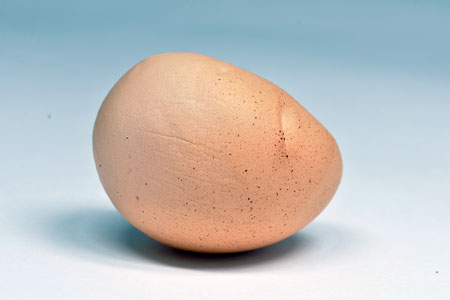
Many things affect an egg’s shell color, texture, and strength. Among them are improper nutrition, environmental stress, age, and disease. Let’s look at some of the most common reasons why chickens lay eggs with abnormal shells.
Poor Nutrition
Improper nutrition can cause hens to lay eggs with soft shells or thin shells that crack easily. Maybe the hens aren’t getting enough to eat. For example, in warm weather hens eat less and therefore get insufficient calcium from their ration. Or hens may be getting improperly balanced rations containing too little carbohydrate, protein, vitamin D, or calcium.
Rough shells, on the other hand, may be a sign hens are getting too much calcium, which can cause a phosphorus deficiency. For these reasons, rather than boosting calcium in layer ration, offer hens a free-choice calcium supplement. That way they can eat as much or as little as they need.
Imbalance can also result from feeding old, stale rations. When chickens are pampered, inadequate nutrition often results from too many treats, such as table scraps or scratch grain.
Excessive Stress
Like all living creatures, a chicken has a limited energy reserve. A typical hen has just enough extra energy to adjust to minor unusual events or adapt to small changes in her daily routine.
Excess stress occurs when events or changes are so intense or numerous that they rapidly use up the hen’s energy reserve. In attempting to cope, the hen has too little energy left for her normal daily activities, including egg laying.
Stress might occur because of fright, excitement, or excessive heat. It may also occur when a hen reaches peak production and her egg-making apparatus can no longer keep up. As a result of stress she may lay eggs with ridged or wrinkled shells, thin shells, soft shells, or no shells.
A shell with a flat side or wrinkles may mean the hen was handled roughly. Or, for instance, she recently may have flown down from a high perch, landing hard and damaging a developing egg.
Old Age
A healthy hen may lay for as long as 10 to 12 years. But by that age she won’t lay as well as she did as a young hen, and the shell quality of her eggs will change.
Older hens generally lay larger eggs. As a result, the shells will be thinner.
Thin shells in aging hens also result from progressive osteoporosis, a condition in which the bones become brittle and fragile and fracture more easily. That’s because a hen uses skeletal calcium to form eggshells, so as she ages she gradually loses structural bone.
The eggs of a brown-egg layer generally get paler as each laying cycle reaches its end. But the shells slightly darken again when the new laying cycle resumes after a molt. Over the years, though, as the hen’s eggs get larger, the shells will become gradually paler overall, because the same amount of pigment covers a larger surface area.
Infectious Bronchitis
The membrane lining a hen’s shell gland is similar to the membrane lining her windpipe. So pathogens that attack the respiratory system can also affect the shell gland, where an egg acquires the hard outer shell and its color.
Accordingly, respiratory diseases often cause a hen that normally lays brown-shell eggs to lay pale or even white-shell eggs. And the shell may be unusually thin or missing altogether.
Infectious bronchitis, caused by a coronavirus, is the most contagious disease of chickens. It is a fairly common respiratory illness that can cause a variety of shell anomalies. They include not only thin, pale, or missing shells but also soft shells, rough shells, ridged or wrinkled shells, and misshaped eggs.
Infectious bronchitis starts suddenly and spreads rapidly. Signs include coughing, sneezing, and rattling sounds in the throat that may be more evident at night when hens are on the roost.
The only sure way to get rid of infectious bronchitis is to get rid of the infected chickens, clean up, disinfect, and start over. Reason enough to prevent a flock from exposure in the first place.
Unusual Shells May Be Normal
Despite all the dire possibilities, eggs with unusual shells may also be perfectly normal. This is especially true when they occur occasionally or seasonally. So when a chicken lays an egg with an abnormal shell, consider the most likely reasons before jumping to conclusions about the health of your hens.
And that’s today’s news from the Cackle Coop.
Gail Damerow is author of The Chicken Health Handbook.

